
Summary of results
Measurements of air pollution and climate inside and just outside of microclimate frames with and without paintings in 12 museum sites and 1 frame making company in Europe have been performed.
The measurements sites were:
1. SIT-Artyd, workshop, Madrid, Spain
2. NG, National Gallery, Oslo, Norway
3. EH-A, English Heritage, Apsley House, London, UK
4. EH-K, English Heritage, Kenwood, London, UK
5. Tate B, Tate Britain, London, UK
6. Tate S, Tate Store, London, UK
7. SMK1, “Statens Museum for Kunst” 1, Copenhagen, Denmark
8. SMK2,“Statens Museum for Kunst” 2, Copenhagen, Denmark
9. MBV, Fine Art Museum, Valencia, Spain
10. MNA, National Museum of Art, Mexico City, Mexico
11. GNM, Germanic National Museum, Nurnberg, Germany
12. NMK1, National Museum in Krakow (Leonardo frame), Poland (PROPAINT “logo frame”)
13. NMK2, National Museum in Krakow (new frame), Poland
The measurements were performed with three different kinds of dosimeters developed in previous EU projects: The Early Warning Organic (EWO) dosimeter developed by the Norwegian Institute for Air Research (NILU, Norway) in the EU project MASTER (EVK4-CT-2002-00093), the Resin Mastic (RM-PQC) and Lead coated Piezoelectric Quartz Crystal (L-PQC) dosimetersdeveloped by Birkbeck University (United Kingdom) in the EU projects MIMIC (EVKV-CT-2000-00040) and SENSORGAN, respectively, and the Glass Slide Dosimeter (GSD) developed by the Fraunhofer Institute (Germany) in theEU project AMECP (EV5V-CT-92-0144). In addition concentrations of inorganic (NO2, SO2, O3) and organic (acetic and formic acid, formaldehyde, TVOC) gaseous air pollutants were measured with diffusive passive samplers, and climate (T, RH and Light / UV) was measured. The geometrical properties and materials in and design of the frames were registered and the ventilation rates of the frames measured with the “escaping CO2” technique.
The inorganic gases are ventilated into rooms and frames from the outdoors and low concentrations of the gases were measured inside the frames. The highest concentrations were measured inside frames at central city sites and for less well sealed frames. However, concentrations did not show simple correlation with measured ventilation rates probably due to different deposition to the different frames on infiltration. The organic gases are emitted from materials inside the frames and high concentrations of VOCs, of which the organic acids are suspected to be the potentially most harmful, were measured inside the frames. Similarly two types of dosimeters (EWO and RM-PQC) were found to be sensitive to photo oxidation and showed high results outside the frames. The two dosimeters (GSD and L-PQC) were found to be sensitive to acids and showed high results inside the frames. Environmental dose response functions were produced for the dosimeters based on statistical correlation of the measured values for the environmetal parameters and the dosimeters. It was found that combined use of two types of dosimeters made possible a more complete and thus better evaluation of the environmental conservation conditions for the paintings with regards to gaseous pollutants, and should thus be recommended.
An environmental evaluation diagram based on dosimeter measurements, including threshold for tolerability for locations with different degree of protection, has been produced to facilitate assessment of preservation conditions in museums including micro climates such as painting frames.
Based on the measurement results and threshold evaluation a model has been produced and modeling of pollutant impact load to paintings has been performed. From the modeling it can be determined if better sealing or alternatively ventilation of a micro climate frame will reduce the gaseous pollution impact load on the painting, given measured present pollutant concentrations, ventilation rate and determined threshold levels for oxidizing and acidic gases. The maximum “tolerable levels” of the concentration of organic acids inside the microclimate frames, for which the frames would still offer protection against the impact of gaseous pollutants as compared to the situation without mc-frame protection, was determined from the modelling.
In addition to the environmental evaluation, six different varnishes were selected and prepared for accelerated ageing exposure in the laboratory and natural exposure inside and outside mc-frames in end user museums during a period of about two years. Dammar and mastic resins were selected as natural resins, and Paraloid B72 and MS2A as synthetic resins. Moreover, dammar and MS2A were selected for study without and with the presence of Tinuvin 292, a light stabilizer, in order to evaluate its antioxidant properties. It was found that:
· Natural ageing has a big impact on the ageing of natural resins. Reticulation and polymerisation reactions occurred at a high degree, to an extent that artificial ageing effects are difficult to be interpreted.
· Tinuvin 292 reduces cross linking and polymerisation reactions depending on the ageing conditions, and is extremely efficient in preventing the oxidation of Dammar triterpenoids under all artificial ageing conditions tested.
· Exposure to high concentration of acetic acid shows an important oxidative effect, to an extent that seems to annul the protective effect of Tinuvin 292 in dammar resin samples.
· For B72, DSC, DMA, ATR/FTIR and SIMS measurements showed a difference between varnish samples exposed within and outside of a showcase in the Uffizi gallery, within and outside the mc frames in the art gallery in Valencia, and in the case of the Leonardo painting (Krakow) located in a more open enclosure as compared to a painting in a new frame in Krakow. Differences between samples exposed inside and outside of mc-frames were also confirmed by AFM. Significant change was observed for varnish samples that had undergone accelerated ageing using glacial acetic acid vapour.
· For MS2A, DSC and ATR/FTIR measurements showed differences between samples of MS2A with Tinuvin exposed inside and outside of theshowcase in the Uffizi gallery. Also there was a measurable difference between MS2A alone and samples of MS2A with Tinuvin.
· MALDI_MS showed measurable differences between samples of natural varnish (resin mastic and dammar) exposed inside and outside of mc-frames in Valencia and in Krakow.
